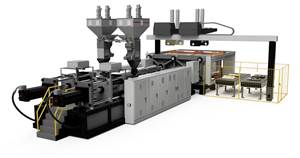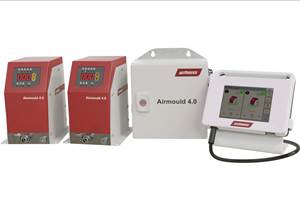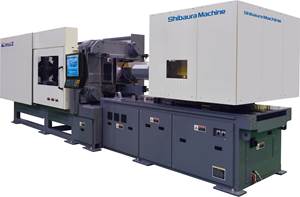Sequential Gating & Gas Assist Team Up for the First Time
Two fast-growing injection molding techniques—valve-gate sequencing and gas-assist technology—have come together in one application for what is said to be the first time. The part that united the two technologies was a 14 x 30 in. x 120-130 mil computer panel being converted to plastic from metal by Hewlett-Packard Co. in Roseville, Calif. It posed a number of process problems that were best solved by combining the two procedures.
Big and challenging
The 3.5-lb panel was molded using Cycoloy C2800, an ABS/PC material from GE Plastics, Pittsfield, Mass. It had to be absolutely flat and show no flow lines, so the part would require no paint or secondary operations. The part also has a molded-in feature that allows the panel to snap-fit onto a steel frame without needing fasteners. Gas-assist expert and consultant Mike Caropreso suggested the combination of gas assist and sequential valve gating.
"Using a traditional single valve-gate approach on a part this large would have required a 1400-ton press, and it would have run the risk of creating sink marks in any area where the plastic is thicker," says Caropreso, who is president of Caropreso Associates in Chester, Mass.
The molder, APW Enclosure Systems of Anaheim, Calif., agreed. "From the time we began looking at this part, we could tell it was going to be a significant challenge," says Gary Nord, plastics operations manager. "Our plans were to purchase a new, large press that would be dedicated to this job, so the expenditure would have been great. But assuming that we went this route, it would have been very difficult to meet the customer's quality requirements. Warpage is always a serious concern on anything this large. In addition, the part has a considerable number of features such as bosses and ribs on one side. I'm sure that we would have had sink-mark problems that would have been difficult, perhaps impossible, to resolve."
Two techniques team up
In this application, sequential valve gating helps prevent flow lines from forming during injection, while gas assist helps to pack out the part, keeping it flat and diminishing the potential for sink marks. Without sequential gating, it would be difficult to ensure that the gas could be directed into the areas with complex features that were prone to sinks. Without gas assist, it could be possible to make the part flat, but the likelihood of a long, noticeable knit line would require painting.
"From the beginning, I felt this would be an ideal application for gas-assist molding," says Caropreso. "By eliminating the need for the press to provide packing pressure, it was obvious that gas assist would make it possible to produce the job on a smaller machine." Mold-filling analysis confirmed his idea. The project teams determined that a press of only 720 tons was needed to mold the part, instead of the 1400-tonner originally forecast. Downsizing the press contributed operating cost savings of $90/hr. The press was purchased from Toshiba Machine Co., Elk Grove Village, Ill.
Planning the process
Valve-gate sequencing was critical in order to precisely control the flow and direction of material through the mold. "Sequencing the filling process made it possible to place the short shot exactly where it needed to be," says Caropreso. Incoe Corp. of Troy, Mich., which pioneered in valve-gate sequencing, supplied its Clear-Flo hot-runner valve-gate system for this application. The Clear-Flo nozzle has two channels, one that acts as a bay for the pin when it is actuated, and a separate, unrestricted channel for the flow of the melt. Thus the pin only contacts the melt just prior to valve closing. In other valve-gate designs, which place the pin in the middle of the flow channel, "It causes stress in the material as the polymer flows around it," says Jack Steele, v.p. of engineering and sales at Incoe. "The velocity of the material on the back side of the pin is different from that on the front end, and this results in flow-induced shear. Material can also build up on the back side of the pin. This can create blemishes or worse on a part when that material is pushed out," he notes. The Clear-Flo system, commercial since 1994, now has a new valve actuator, which operates with either hydraulic or pneumatic pressure.
To mold the H-P panel, APW also uses Incoe's gate-sequence controller—proprietary software that links pin movement to the linear travel of the screw in the injection machine. The pin can also be actuated by time. The system allows for two open/close sequences per cycle for each valve gate.
The project required using two valve gates in off-center positions. "If the gate were placed in the center of the mold, then four corners of the part would be short shot," says Caropreso. The short shot was desired in only one corner that contained a lot of features such as stiffening ribs, where sink marks would likely occur and where the gas assist could be the most effective. Mold-filling analysis determined the best gating positions.
APW tried a number of gate opening and closing sequences. The best solution was when the first valve gate opened to allow a metered amount of melt into the cavity, and the second gate opened just as the flow front from the first gate reached it. APW tried closing the first gate when it opened the second, but the results were not favorable. In some areas nearer to the first gate there were no gas channels to pack out the features, so continued injection pressure was required to finish filling those features. "The number one valve gate was closer to certain features, while the gas would take care of features on the other end," explains Caropreso.
The tool, built by L.B. Mold, Gardena, Calif., has a gas channel running down either side of the 30-in.-long edge and then wrapping around one of the 14-in. sides (which start out short-shot). The gas is introduced into the mold and evacuated using a bi-directional pin. Overall, the mold was short shot by 1-2%. The nitrogen gas-assist technology, which is also linked electronically to the primary injection unit, was supplied by Gain Technologies, Sterling Heights, Mich.
Related Content
Structural Foam Injection Molding Line Extended
At K 2022, Wilmington Machinery introduced the dual-injection Lumina MP1200 medium pressure molding machine.
Read MoreInternal Gas Pressure Molding Offers Sustainability Benefits
Wittmann Battenfeld says its upgraded Airmould 4.0 technology, which features a more compact footprint, saves material and cycle time — thereby also cutting energy use.
Read MoreFakuma 2023: Wittmann Battenfeld Expands All-Electric Line, Direct-Current Capabilities
Wittmann Battenfeld will introduce the new EcoPower B8X injection molding machine line and show direct current as an energy source for a concept machine that will power its own robot.
Read MoreCompletely Connected Molding
NPE2024: Medical, inmold labeling, core-back molding and Industry 4.0 technologies on display at Shibaura’s booth.
Read MoreRead Next
People 4.0 – How to Get Buy-In from Your Staff for Industry 4.0 Systems
Implementing a production monitoring system as the foundation of a ‘smart factory’ is about integrating people with new technology as much as it is about integrating machines and computers. Here are tips from a company that has gone through the process.
Read MoreWhy (and What) You Need to Dry
Other than polyolefins, almost every other polymer exhibits some level of polarity and therefore can absorb a certain amount of moisture from the atmosphere. Here’s a look at some of these materials, and what needs to be done to dry them.
Read More (2).jpg;maxWidth=970;quality=90)






 (2).jpg;maxWidth=300;quality=90)
















